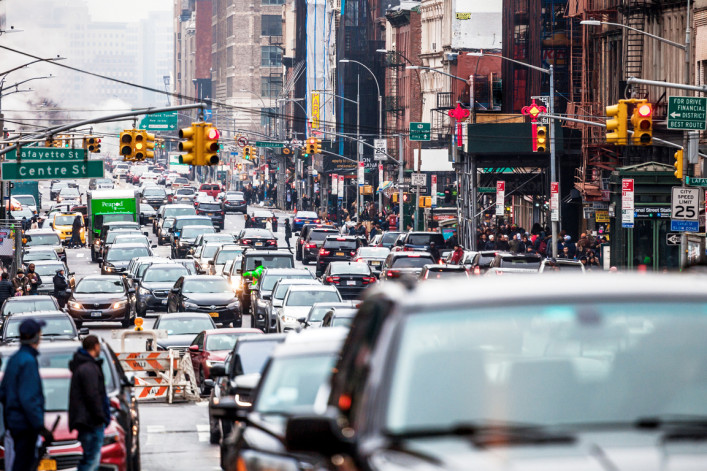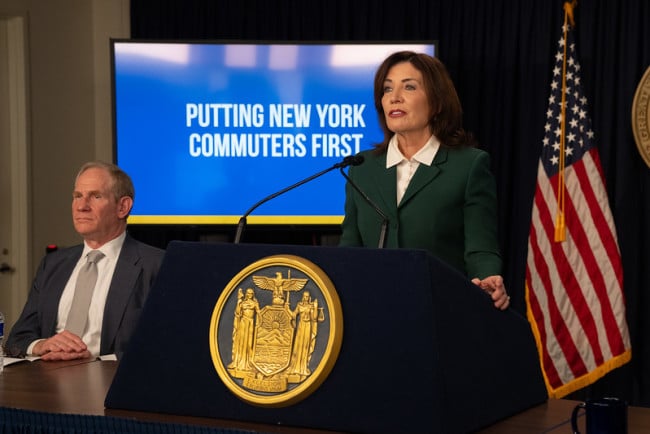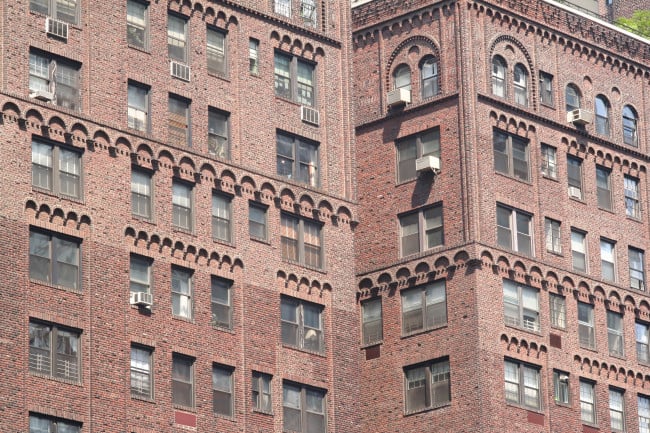Congestion pricing adds a new twist for buyers, sellers, and renters
- Some brokers expect the plan to eventually ‘drive up prices’ in the zone below 60th Street
- Buyers may need to ask if a building’s income from a retailer or parking garage is affected

If congestion pricing goes as planned and reduces noise and pollution, properties in the zone could be valued even higher.
iStock
If you have a reverse commute and are shopping for a new apartment, you may have just crossed all of Manhattan below 60th Street off your wish list. Or maybe you own an apartment Downtown, a place you’re preparing to sell. You may be crossing your fingers and hoping that the cacophony of gridlock will improve sometime after midnight on January 5th.
That’s when a new $9 toll for passenger cars goes into effect for vehicles entering Manhattan below 60th Street, thanks to a revamped version of congestion pricing reinstated by Governor Kathy Hochul.
The goal of congestion pricing is to “unclog our streets and reduce pollution” and support the MTA’s capital plan to upgrade mass transit, Governor Hochul said. Fees from the plan are expected to pay for $15 billion in mass transit improvements, including upgraded signals on six subway lines, an extension of the Second Avenue subway to East Harlem, accessibility improvements like elevators at more than 20 stations, and hundreds of new electric buses.
For buyers, sellers, and renters, congestion pricing adds a new and largely unknown factor. Brick heard from brokers about the potential impact the plan could have on real estate deals.
Less traffic = higher prices?
Most brokers said that at the moment, buyers and sellers are trying to get their bearings and see how the new plan affects them.
Abigail Palanca, an agent at SERHANT, expects there will be a temporary sales slowdown for properties in the new pricing zone below 60th Street.
“The clients I am working with are factoring in having a car, how often they drive, and what that potential impact on affordability is,” Palanca said. For Manhattanites who live there, she said she doesn’t think it will change their behavior. “If you need to drive through the city, what is the likelihood that the additional cost will push you to take the subway?
But reducing traffic coming into the area could have an impact. “I do think long term, it has the potential to make it a more desirable place to live,” she said.
Greater desirability leads to higher prices (of course), several brokers told Brick.
If congestion pricing goes as planned and improves livability, properties in the zone could be valued higher, said John Walkup, co-founder of UrbanDigs, a real estate analytics company.
“Reduced traffic means less noise and pollution, leading to improved air quality and better overall street conditions. This could make the area more attractive to buyers and perhaps cause a bump in prices as the quality of life improves,” he said.
Laurel Ferrera, an agent at Keller Williams NYC, pointed to Londoners’ experience with congestion pricing, which led to an increase in prices.
“When London introduced something similar, home values in the area increased by 3.68 percent relative to homes located just outside the zone, which equated to an additional $13 billion across those properties,” Ferrara said, citing research from Cheng Keat Tang at the London School of Economics.
The paper suggested the increase reflects buyers’ “willingness to pay more to live inside the zone with less traffic and noise and better air quality,” Ferrera said, adding that it seems likely that prices will also rise in Manhattan’s congestion zone.
Buyers may see the congestion zone touted in listings.
Reduced traffic and quieter streets are an “opportunity for brokers to position these homes as offering enhanced lifestyle benefits, which may or may not affect overall pricing. Depending on the actual effect of congestion pricing, it will resonate particularly with buyers and tenants who prioritize a refined living experience over cost considerations,” said Kevin Huang, an agent at Elegran-Forbes Global Properties.
North of the zone
Several brokers were skeptical that congestion pricing would impact buyer behavior in a significant way.
“I could see listings north of the boundary seeing a surge in activity in reaction to the new tolls, especially for buyers who own automobiles, but I don't see buyers paying exponentially higher prices to avoid what could amount to around $300 in extra monthly tolls for people who drive on a regular basis,” said Douglas Wagner, director of brokerage services for BOND New York Properties.
A reason to finally move
Congestion pricing could accelerate a plan to head Uptown if your kids are switching to a school in a different neighborhood—a common phenomenon in NYC where students can live in one neighborhood and to school in another.
“I've polled clients informally and it's too early to tell. That said, I imagine that properties within the congestion zone will suffer, if anything, because of a reluctance for anyone with a car to park there. It will likely expedite any decisions to move from, say, Downtown to Uptown if kids are moving to Uptown schools,” said Scott Harris, a broker at Brown Harris Stevens.
Commercial real estate fears
Some business owners and commercial real estate owners are nervous about congestion pricing.
A group of business owners announced a class action suit in February against congestion pricing, arguing it would hurt business for restaurants by discouraging patrons and force small business owners to cut back on staff and hours. (At that point, New Yorkers were awaiting implementation of an earlier iteration of the plan with a $15 fare for passenger cars.)
Small business owners remain concerned about a double whammy: There’s a fear congestion pricing will deter non-Manhattan consumers from driving into the city, hurting businesses that depend on foot traffic, while at the same time creating higher costs for doing business.
Huang said it remains to be seen if there will be a “ripple effect of congestion pricing [that] extends into a restaurant’s supply chain, with increased tolls driving up supplier costs, raw material and ingredient prices, and ultimately, menu prices for customers.”
Similarly, David Sokolowski, a broker at Coldwell Banker Warburg, said there’s a risk of a “trickle-down effect” that “could continue to be passed down to the people that live in this zone, through higher costs at local establishments and other businesses.”
Another open question: Will residential buildings that depend on income from ground-floor retail and parking garages also be a part of this ripple effect? It’s something for condo and co-op buyers (or their attorneys) to ask about as part of their due diligence.
Congestion pricing around the world
There are many cities around the world which have been living with congestion pricing for years or even decades that New Yorkers can look to as examples—and may find somewhat reassuring.
A 2011 paper by Kiran Bhatt published by the Lincoln Institute of Land Policy studied congestion pricing strategies in London, Stockholm, Singapore, and several U.S. cities—Singapore’s Phase I program was implemented in 1975, for example.
He noted that in every place congestion pricing has been proposed, “retail and commercial interests within the priced zone had strong negative reactions to the proposal, putting forth the argument that the central business district would become much less attractive due to the increased cost of travel to it.”
But he also found little evidence that once implemented, retailers were adversely affected by congestion pricing.
About London, Bhatt wrote, “Annual surveys suggest that businesses in the charging zone have outperformed those outside the zone, and a majority of businesses continue to support the charging scheme, provided investments in public transportation continue.”
Prices could rise in commuter hubs
Andrea Saturno-Sanjana, a broker at Coldwell Banker Warburg, said that properties in areas where commuters cluster could appreciate.
"If commuters outside of the zone are encouraged to take public transportation, there might be price increases in real estate near transportation hubs outside of [Manhattan] and the city,” she said.
Ferrera of Keller Williams suggested that congestion pricing may further incentivize car-free living.
She pointed out that neighborhoods Uptown, like Hamilton Heights, which is only a few express stops from Manhattan, “could become more desirable.”
Some suburban buyers may make good commuter train service, especially express lines, a bigger priority.
But she pointed out that many suburbanites already commute by train. “I wouldn't expect to see much of a change in pricing as this is already the norm,” she said.
You Might Also Like































